Browsing by Subject "Evolution"
Now showing items 1-20 of 129
-
Adaptive Origins: Evolution and Human Development
(Psychology Press, 2010)In this text, students are invited to rethink psychology by grounding it in the natural sciences with the understanding that evolutionary and developmental processes work together with culture to solve problems of human ... -
Are genes faster than crabs?
(2014)Biological invasions offer unique opportunities to investigate evolutionary dynamics at the peripheries of expanding pop-ulations. Here, we examine genetic patterns associated with admixture between two distinct invasive ... -
Aremicrobes fundamentally different than macroorganisms?
(2015)This study reveals extensive phenotypic convergence based on the non-monophyly of genera and morphospecies of testate (shelled) amoebae. Using two independent markers, small subunit ribosomal DNA (ssu-rDNA) and mitochondrial ... -
Attack risk for butterflies changes with eyespot number and size
(2016)Butterfly eyespots are known to function in predator deflection and predator intimidation, but it is still unclear what factors cause eyespots to serve one function over the other. Both functions have been demonstrated in ... -
Back to Tanganyika
(2015)The species flocks of cichlid fishes in the East African Great Lakes are the largest vertebrate adaptive radiations in the world and illustrious textbook examples of convergent evolution between independent species ... -
Baleen boomand bust
(The Royal Society, 2015)A new, fully dated total-evidence phylogeny of baleen whales (Mysticeti) shows that evolutionary phases correlate strongly with Caenozoic modernization of the oceans and climates, implying a major role for bottom-up physical ... -
The cervical anatomy of Samotherium,an intermediate-necked giraffid
(2015)Giraffidae are represented by many extinct species. The only two extant taxa possess diametrically contrasting cervical morphology, as the okapi is short-necked and the giraffe is exceptionally long-necked.Samotherium ... -
Coevolutionary interactions between farmers andmafia induce host acceptance of avian brood parasites
(2016)Brood parasites exploit their host in order to increase their own fitness. Typically, this results in an arms race between parasite trickery and host defence. Thus, it is puzzling to observe hosts that accept parasitism ... -
Coexistence of three sympatric cormorants
(2016)Resource partitioning is well known along food and habitat for reducing competition among sympatric species, yet a study on temporal partitioning as a viable basis for reducing resource competition is not empirically ... -
Cognitive Search: Evolution, Algorithms, and the Brain
(MIT Press, 2012)Over a century ago, William James proposed that people search through memory much as they rummage through a house looking for lost keys. We scour our environments for territory, food, mates, and information. We search for ... -
Comparative phylogenetic analyses uncover the ancient roots of Indo-European folktales
(2016)Ancient population expansions and dispersals often leave enduring signatures in the cultural traditions of their descendants, as well as in their genes and languages. The international folktale record has long been regarded ... -
Competition and cooperationina synchronous bushcricket chorus
(The Royal Society, 2014)Synchronous signalling within choruses of the same species either emerges from cooperation or competition. In our study on the katydid Mecopoda elongata, we aim to identify mechanisms driving evolution towards synchrony. ... -
Conflict between background matching and social signalling in a colour-changing freshwater fish
(2016)The ability to change coloration allows animals to modify their patterning to suit a specific function. Many freshwater fishes, for example, can appear cryptic by altering the dispersion of melanin pigment in the skin to ... -
The contribution of seed dispersers to tree species diversity in tropical rainforests
(2015)Tropical rainforests are known for their extreme biodiversity, posing a challenging problem in tropical ecology. Many hypotheses have been proposed to explain the diversity of tree species, yet our understanding of this ... -
Cooperation and Its Evolution
(MIT Press, 2013)This collection reports on the latest research on an increasingly pivotal issue for evolutionary biology: cooperation. The chapters are written from a variety of disciplinary perspectives and utilize research tools that ... -
The Cradle of Humanity: How the Changing Landscape of Africa Made Us So Smart
(Oxford University Press, 2017)One of the fundamental questions of our existence is why we are so smart. There are lots of drawbacks to having a large brain, including the huge food intake needed to keep the organ running, the frequency with which it ... -
Crypsis via leg clustering
(2015)The role of background matching in camouflage has been extensively studied. However, contour modification has received far less attention, especially in twig-mimicking species. Here, we studied this deceptive strategy by ... -
Darwinism as religion: what literature tells us about evolution
(Oxford University Press, 2017)The Darwinian Revolution--the change in thinking sparked by Charles Darwin's On the Origin of Species, which argued that all organisms including humans are the end product of a long, slow, natural process of evolution ... -
Deceived by stripes
(2016)Conspicuous coloration, which presumably makes prey more visible to predators, has intrigued researchers for long. Contrastingly coloured, conspicuous striped patterns are common among lizards and other animals, but their ... -
Discrete but variable structure of animal societies leads to the false perception of a social continuum
(2016)Animal societies are typically divided into those in which reproduction within a group is monopolized by a single female versus those in which it is shared among multiple females. It remains controversial, however, whether ...




















